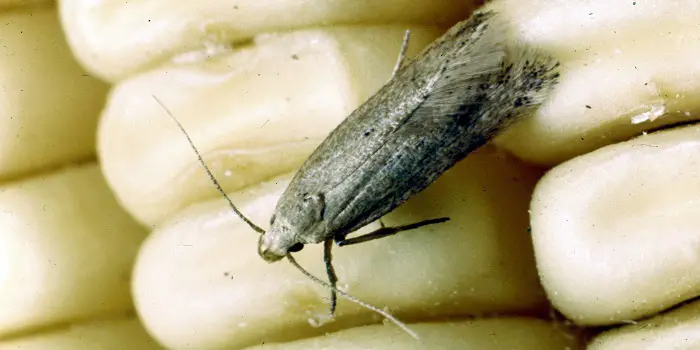
Of the many pests that farmers must contend with on their properties, the Angoumois Grain Moth is one of the most annoying.
Located worldwide, the moth will infest and feed on different types of crops, most notably ears of corn that are often grown in the US.
If not addressed, the moth will consume a considerable amount of the crop, which may cause financial distress for the farmer.
What is an Angoumois Grain Moth?
What makes the Angoumois Grain Moth dangerous to crops in their rate of reproduction?
Because the females will lay their eggs frequently in the warm weather months, a few moths can quickly become a swarm and spread across the fields.
While their most notable target is ears of corn, they also consume a wide variety of other crops, including the following.
- Barley
- Millet
- Rice
- Sorghum
- Wheat
If they make it inside the home, you may find them feeding on popcorn kernels that are left out in the open.
There is little doubt about how dangerous they can be to crops, even if they do not cause any direct harm to humans or pets.
Getting rid of the Angoumois Grain Moth starts with proper identification so that you can take the appropriate action.
How to Identify Them?
The Angoumois Grain Moth is similar in size and general shape to most moths.
Adults are roughly 1.5” long and have small wings of roughly 3/8th of an inch long attached to the front of their bodies. The wings tend to have a yellow tint.
What makes this species different is they have a narrow projection that extends from the back of their wings.
This small projection is different than virtually all other moths and helps to distinguish them.
This means that if you see a moth fluttering around a light source at night, it might be an Angoumois Grain Moth.
But you must look closely at the wings to see the projection. Most moths tend to have smooth wings or no projection at the back.
The larvae, when fully grown, are usually 1/8th of an inch long and tend to be yellow and white in color with a head that may be yellow and brown.
But it is where you will find them that makes the larvae distinguishable.
Ears of corn tend to be their favorite place. If you see a kernel of fresh corn with a small hole, you can assume that the larvae will be inside.
If you are still not sure, then you should call an expert to verify.
There are many pest control companies that can help in the identification process and provide solutions for getting rid of them.
If you have made the identification yourself, then the next step is removing them from your property.

How to Get Rid of Angoumois Grain Moth?
After you have cleaned your home, it’s time to treat the areas so that you can get rid of these insects completely.
What follows are the steps you should take to eliminate the moth and larvae.
By following all the steps, you should remove them from your home.
1- Remove All Infested Food
All food that has larvae present should be tossed into a trash bag, sealed, and then removed from your home quickly.
Be sure to inspect every bag and container on all the shelves.
This means putting them in one location, keeping the food that has not been infested, and removing the rest.
You will have to conduct a careful search.
This means pouring the food out of the bag or container, inspecting it closely along with the container, then putting the food in a new container and storing it in a safe location until you have fully cleaned and disinfected the area.
If you are not sure, then throw away all the food that was inside the cabinet itself.
Tossing out that much food may sound drastic, but it may be the only way to be sure.
Larvae in the early stages can be difficult to spot. So, better safe than sorry by tossing out everything.
2- Vacuum & Clean
Now that all the food has been removed and inspected, the next step is to vacuum the storage areas.
A vacuum will pick up all larvae and perhaps even a few of the adult moths.
You’ll want to vacuum the entire area. This includes the shelves, top, bottom, corners, and crevices to ensure that you have gone over every hiding place the moths may find.
One place that often harbors the eggs laid by the female moths is the pegs where the screws are located.
Use a toothpick to clean around the area, which should pick up and destroy any eggs that might be remaining.
With the entire area vacuumed, you are ready to clean using soapy water and a cloth.
Soak the cloth in the soapy water and clean all the surfaces, especially around the screws on the pegs and any crevices which may still be hiding the larvae or eggs.
The soapy water will kill both the eggs and larvae, so you can keep the cabinet open to let it dry or use a dry cloth to pick up the water.
Once completed, you can use caulk to fill in any cracks or crevices to prevent any larvae which may still be present from escaping.
3- Spray Insecticide
Once everything is cleaned, you are now ready to use the spray.
To get rid of the Angoumois Grain Moth, you should be using an insecticide aerosol that not only destroys the moths but the larvae and eggs, thanks to the inclusion of an Insect Growth Regulator (IGR).
In addition, one good spray means that you prevent the moth from returning for several months, depending on the strength of the product.
To properly spray the area, shake the can and hold it upside down for maximum effect.
This will ensure that the contents used will come out in a more concentrated form.
Spray the floor, walls, shelves, corners, and all parts of the cabinets, storage areas, and the like.
Be sure to wear gloves, a mask, and eye protection when using the product.

Where to Find Angoumois Grain Moth?
The first step of getting rid of them is finding them to get them out of your home.
This means you will need to inspect the inside of your home, particularly around food sources, to find the larvae.
The best places to start are kitchen cabinets and other food storage areas containing the products they enjoy.
If you have popcorn kernels that are either set out in the open or kept in a cabinet, that is a good place to start.
Other places to look include but should not be limited to the following.
- Cabinets, Pantries, and Shelves with food
- Sacks or boxes of cereal, grains, herbs, corn, pasta, flour, starches, and the like
You are looking for the moths and the larvae that tend to infest such products directly.
If you discover any food item that has the larvae inside, get it out of the house immediately.
The adult moths may be nearby along the walls, top, or bottom of the cabinet area.
Remember to look in all places in which you keep food.
This includes the refrigerator and freezer, although the chances of the moth or larvae being present is slim.
Remember to look in all storage places as well. This includes storage rooms, barns, or sheds.
Plus, if you keep food in vehicles, RVs, or campers, be sure to look there as well.
How to Prevent Future Infestation of the Grain Moths?
Angoumois grain moth larvae usually have an awful scent, due to which they leave the infested grain smelling bad.c
That’s the reason grain infested by the Angoumois grain moth larvae is less attractive for consumption or becomes inedible completely.
Angoumois grain moths are not only considered bad for pantry goods but also can be serious agricultural damage.
Since they can remain active at low temperatures, they tend to cause damage to field crops even during the winter months in many areas.
And for this reason, these grain moths are a great concern for growers and producers.
One of the best ways to prevent infestation is to put your food inside plastic containers.
While more expensive, it prevents the moths from reaching the dried food.
In addition, remove any clutter from the shelves to prevent the moths from finding hiding places.
In addition to using the aerosol, you can place moth traps inside the cabinets, pantries, and shelves, which will trap them before they get to your food.
The traps are generally good for about three months, so be sure to replace them at regular intervals.
If you need to apply insecticides for killing AGM, Novacide and a few other sprays can work.
Be sure to use only an approved insecticide product if you are using it for spraying field crops and other agricultural products.
The Conclusion
Prevention can go a long way towards keeping the Angoumois Grain Moth from infesting your food sources.
Keep in mind that if your food storage areas have been invaded by the Angoumois Grain Moth before, they likely will again unless you have properly sealed the room or location.
Conduct regular inspections, especially during warmer weather, to spot an infestation in the early stages.
The earlier you discover the moths, the easier they will be to remove.
Once you have discovered the infestation, you will need to take measures to clean up your home.
This is because what you see may only be part of the entire nest or invasion from the moth.
Share the post "Angoumois Grain Moth – Identification & Prevention Tips"

Welcome to ProShieldPest.com. I am Tina Jones. I have been working as a pest removal professional in Winslow, Arizona lately. At present, I love to spend my time with my family as a retiree.
Here I share all my knowledge and experiences to help people understand better how they can stop pests at their homes without actually killing them. Hopefully, the information you will find here will help in safeguarding your home! You can check more about me here.





